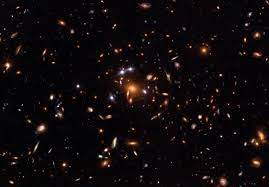Gravitationally Lensed : Captured Image

Astronomers have recently captured four images of the same background supernova being gravitationally lensed by the immense gravitational well of the foreground supernova.
- Gravitational Lensing occurs when a massive celestial body, such as a galaxy cluster, causes a sufficient curvature of spacetime for the path of light around it to be visibly bent, as if by a lens.
- The body causing the light to curve is accordingly called a gravitational lens.
- An important consequence of this lensing distortion is magnification, allowing us to observe objects that would otherwise be too far away and too faint to be seen.
- Gravitational Lensing was first predicted in 1915 by Albert Einstein, which involves the bending of light by objects of great mass.
- According to Einstein’s general theory of relativity, time and space are fused together in a quantity known as spacetime.
- Within this theory, massive objects cause spacetime to curve, and gravity is simply the curvature of spacetime.
- As light travels through spacetime, the theory predicts that the path taken by the light will also be curved by an object’s mass.
- Gravitational lensing is a dramatic and observable example of Einstein’s theory in action.
- Extremely massive celestial bodies such as galaxy clusters cause spacetime to be significantly curved. In other words, they act as gravitational lenses.




